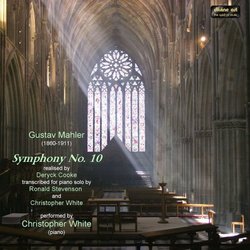Musical sideshow
Mark Shanks | Portland, OR | 04/14/2010
(2 out of 5 stars)
"When the pianist/transcriptionist can't convey his rationale for his work, you're in trouble. "Why not?" isn't a good answer, not when you're tackling a problematic piece to begin with. Of course, Mahler's "10th" was unfinished and unperformed for decades, and it was quite a big deal when that old phoney Alma finally "allowed" a performance of the Deryck Cooke "realisation". Ronald Stevenson and pianist Christopher White have "deconstructed" that and created, not really a transcription but a piece for solo piano. And for me, it doesn't work. The greatest moments of the symphony, the horrific orchestral shriek at the rending of the veil between life and death in the first movement and the huge consolatory theme of the conclusion, are lost in the inability of a single instrument to provide a worthy palette. The notes are there, but its soul has been drained. The opening would sound at home as a soundtrack for a "spooky movie" - gone is any tension. The signature muffled drum closing the fourth and opening the fifth movements is achieved by a forearm over the keys and heavy pedal. Unfortunately, it sounds too much like Akira Ifukube's soundtrack for "Gojira", specifically the scene in Serizawa's lab when he demonstrates the Oxygen Destroyer. (Bet you didn't see *that* coming!)
Really a curiosity piece. If you are a completist (like me), maybe you'll want it. But I certainly couldn't recommend it for anyone not VERY familiar with the orchestral version, and I'm still scratching my head over.....why?"


 Track Listings (5) - Disc #1
Track Listings (5) - Disc #1